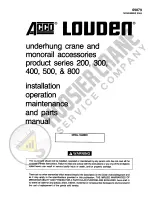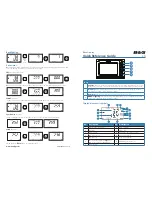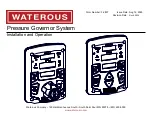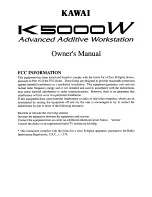
18
19
LFO RATE
- Sets the frequency of modulation of the Delay Line by the
LFO. The
RATE
can be varied from .05 Hz to about 50 Hz. The
LFO RATE
LED indicates both the
RATE
and
WAVEFORM
of the current LFO settings.
The LED is red when the
RATE
is set from the front panel, green when the
rate is set by the
TAP TEMPO
switch, and orange when the
LFO
is synced
to MIDI clock. When synced to MIDI clock, the
RATE
control is quantized to
select only rhythmic subdivisions of the MIDI clock tempo.
LFO AMOUNT
- Sets the overall amount of modulation of the Delay Line
by the LFO.
Note: As the LFO Amount increases, the functional range of the
DELAY TIME
control
is decreased, so that the maximum and minimum delay times are not exceeded
.
BYPASS
- Used to turn the effect
ON
and
OFF.
When the effect is on the
Bypass LED is green. When the effect is in
SPILLOVER
mode the
BYPASS
LED is orange. When the effect is off the
BYPASS
LED is red.
TAP TEMPO
- Dedicated switch used for setting the
DELAY TIME
or the
LFO RATE
to a musical tempo.
To initiate Tap Tempo control of the
DELAY TIME
, press the
TAP TEMPO
switch three times with the tempo you want (quarter notes). On the third
press, the
TIME
LED
will change to Green, and the
DELAY TIME
will change
rates to match the timing of the switch presses.
If you continue to press the
TAP TEMPO
switch, the
TIME
will be set by a
running average of the time between switch presses. To start over, wait
five seconds and then press the
TAP TEMPO
switch three times to set a
new tempo.
To revert the unit to front panel control, simply turn the
TIME
control. The
TIME LED
will turn red, and the
DELAY TIME
will set by the panel control.
To initiate Tap Tempo control of the LFO, press and hold the
TAP TEMPO
switch for at least one second. The LFO LED will flash green to show that
the tap tempo is now routed to the LFO and not the
DELAY TIME
. To
change back, press and hold the
TAP TEMPO
switch again until the
TIME
indicator flashes green.
When Tap Tempo is routed to the LFO pressing the switch three times or
more will set the LFO rate to match the tap time. Turning the
RATE
knob
reverts the unit back to front panel control.
Note: When either destination (time or LFO) is synchronized to MIDI Clock messages,
Tap Tempo is disabled for that destination only
.
OUTPUT LEVEL -
Sets the strength of the Analog Delay output at the
MIX OUT
and
DELAY OUT
jacks. This control is only active when the effect
is on or in Spillover mode. The
OUTPUT LEVEL
control is designed so that
an overall boost, attenuation or zero gain state can be achieved with any
DRIVE
setting.
MIX -
Sets the ratio of dry (signal as input) to wet (effected) signal. This
control is only active when the effect is on. Set fully counterclockwise it
allows only the dry signal to pass to the
MIX
output. The full clockwise
position allows only the wet signal to pass to the
MIX
output. Any position
between the two will blend wet and dry signal to the output. The
DELAY
OUT
signal is not affected by the
MIX
control.
Note: If you’re applying a sustained steady pitch to the MF-104M and the
MIX
control
is set near 12:00, you may find that the direct and delayed signals alternately reinforce
and cancel each other in rapid succession as the
DELAY TIME
is varied. This is a nor-
mal result of mixing a steady pitch with a delayed replica of itself. It is the analog-
delay equivalent of “standing waves” in a reverberant room.
DELAY TIME
- Sets the length of delay from the BBD Delay Line based
on the
SHORT/LONG
(Delay Range) switch setting. In
SHORT
mode, with
AMOUNT
set to 0, the delay time changes from approximately 40ms to
400ms nominal. In
LONG
mode the available span is from approximately
80ms to 800ms nominal. The
DELAY TIME
is modulated via the LFO to
create various effects.
Since the delay’s internal anti-alias filter must change for the delay time,
the
SHORT
setting will yield a higher frequency response for the same delay
time as
LONG
. Switching from
SHORT
to
LONG
will reduce the sound in
the “feedback loop” one octave, while switching the other direction will
double the pitch and time of the loop sound.
FEEDBACK
- Sets the amount of Delay Line output fed back into the input
of the Bucket Brigade Device. The feedback is variable from off, slapback
or single repeats, to continuous repeats (at about the 3:00 setting). When
turned past 3:00, the
FEEDBACK
provides for self-oscillation and swelling
delay sounds.
WARNING:
The Analog Delay Feedback control is able to drive the Delay Line into
self-oscillation. This means the Analog Delay is capable of producing sounds without
any audio signal present. Tones produced by self-oscillating feedback may be much
stronger than normal signal levels.
Please watch your speakers and ears
. Oscillation
typically begins at the 3:00 position.
LFO WAVEFORM
- Selects the LFO waveform for modulation of the Delay
Time. There are six waveforms available: Sine, Triangle, Square, Sawtooth,
Ramp and Sample and Hold (Random Stepped) waveforms.
Note: No modulation will be heard with the LFO AMOUNT set to zero.
Summary of Contents for MF-104
Page 1: ......

































